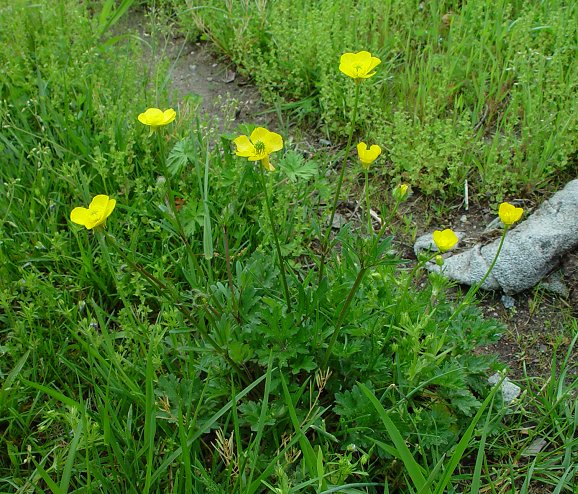Ranunculus bulbosus L.
Bulbous Buttercup

Introduced
CC = *
CW = 0
MOC = 4
© DETenaglia
Ranunculus bulbosus L.Bulbous Buttercup | |
 |
Introduced CC = * CW = 0 MOC = 4 |
© DETenaglia |
|
Family - Ranunculaceae Habit - Perennial forb with a hard base and a hardened or bulbous-thickened base and thickened roots. Stems - Ascending to erect, to 50 cm long, single or typically multiple from the base, fistulose, not rooting at the lower nodes, moderately pubescent with more or less spreading to appressed hairs, lacking bulbils, the base noticeably bulbous-thickened, sometimes appearing cormlike.
Leaves - Alternate, petiolate below, becoming sessile above. Basal leaves present at flowering, the petioles to 15 cm, the blade 2.0-5.3 cm long, 2.5-4.5 cm wide, ovate to more or less heart-shaped in outline, usually compound, with 3 primary leaflets (or lobes), the base cordate, the terminal leaflet usually stalked, the primary leaflets (or lobes) deeply lobed, the segments oblong to obovate, the margins otherwise coarsely toothed, the teeth mostly rounded to bluntly pointed at their tips, the surfaces pubescent. Stipule-like appendages at the base of the leaves scarious, sometimes with two squarish auricles at the apical end. Stem leaves mostly short-petiolate to sessile, progressively reduced toward the stem tip, the blade progressively deeply 3-parted into narrower, less divided and toothed, more sharply pointed segments.
Inflorescence - Axillary and terminal pedunculate flowers. Peduncles to 15 cm, appressed pubescent, green, carinate or not, a small leaf occasionally present on peduncle. Flowers - Sepals 5, 5-7 mm long, abruptly and strongly reflexed along a well-defined transverse fold 2-3 mm above the base, more or less plane. Petals 5, 9-13 mm long, 8-11 mm wide, broadly obovate to orbicular, longer than the sepals, shiny, yellow. Stamens numerous, borne below the carpels. Filaments to 7 mm long, glabrous, yellowish. Anthers yellow, to 3 mm long, oblong. Carpels glabrous, compressed, green, to 3 mm long in flower, quickly expanding in fruit. Receptacle pubescent. Style present.
Fruits - Head of achenes 6-9 mm long at maturity, globose to more or less ovoid, the receptacle hairy. Achenes 2.2-3.2 mm long, the dorsal margin keeled and sometimes narrowly winged, the wall thick, smooth, glabrous, the beak 0.3-0.8 mm long, flattened, lanceolate to broadly triangular, usually tapered to a slender, minute, hooked tip.
Flowering - April - June. Habitat - Pastures, fallow fields, orchards, lawns, gardens, and roadsides. Origin - Native to Eurasia. Lookalikes - Other species of Ranunculus. In particular, this species is easily confused with R. sardous, which is far more common in Missouri. Other info. - This species is apparently uncommon in Missouri, reported thus far from only four widely separated counties. It is far more common eastward, particularly in New England states. The plant can be identified by its bulbous base, truly compound (not simply lobed) basal leaves, and slightly thickened roots. The reflexed sepals and achenes with smooth faces are also good characteristics to help with a proper ID. The degree of pubescence on the stems and leaves is variable. The plant can be differentiated from the very similar R. sardous by its smooth achenes, but this entails a careful search under 10x or greater magnification for the minute pebbling found on R. sardous achenes. Photographs taken in Brown Summit, NC., 4-20-03 (DETenaglia). |